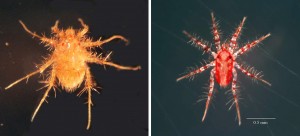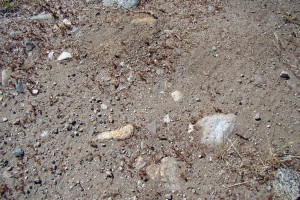Imagine if you…
- could take 100 strides in a single second!
- could run the length 2 football fields in just 1 second!
- ran your fastest at 120°F!
Then if you scaled yourself down to the size of a pinhead you might be able to compete with the…
…whose amazing performance is reported in a recent paper in the Journal of Experimental Biology by Grace Wu (Pomona ’08), Jonathan Wright (Pomona Biology), Dwight Whitaker (Pomona Physics), and Anna Ahn (HMC Biology). These mites were discovered at the BFS by Grace Wu and Prof. Wright, who were looking for suitable subjects for Wu’s senior thesis on kinematics of fast arthropods.
Looking down at the ground…
…they saw running around at incredibly fast speeds some tiny mites, which they identified as an undescribed species in genus Parateneriffia. They subsequently found a second – even tinier – species of Parateneriffia in oak litter.

Left: Parateneriffia sp. 1, which is found on open ground; Right: Parateneriffia sp. 2, which lives in oak litter.
How do these mites run so fast? For help in analyzing the mites’ kinematics, Wu and Wright turned to Ahn, a specialist in animal locomotion and muscle performance, and Whitaker, who analyzes super-fast motion in plants and animals.
Using Whitaker’s high-speed high video camera, the team recorded video of the mites running at different temperatures and analyzed the videos to determine the mites’ absolute and relative running speeds, their stride frequency, and the effect of temperature. Here is one of their videos (shown in real time):
Using Whitaker’s high-speed high video camera, the team recorded video of the mites running at different temperatures and analyzed the videos to determine the mites’ absolute and relative running speeds, their stride frequency, and the effect of temperature. They found that the mites stride frequency is the fastest known for any load-bearing muscles. Since muscles that contract faster generate less force, their findings raise an intriguing question – how can these muscles generate the force needed to support the mite’s weight while contracting at these exceptionally fast frequencies?
The article on the mites is published in the July 16th issue of The Journal of Experimental Biology:


